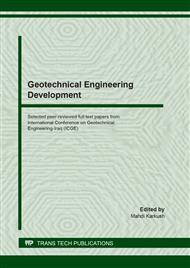p.15
p.22
p.32
p.39
p.48
p.56
p.66
p.74
p.83
Al-Hadba Minaret, a Contribution in Characterizing of its Brick
Abstract:
Al-Hadba minaret is one of the ultimate minarets in beauty and excellence that belonged to the constructions of Zankid dynasties in Syria and upper Mesopotamia. The minaret was built during the 12th entury, it is located in the center of old Mosul city-Northern Iraq. This minaret is the most famous in the Middle East, since it has a significant curvature (banana shape) that threatens its integrity. Unfortunately, the main parts of this monument were destroyed during the last military operations in 2017. Nowadays, there are serious attempts to reconstruct the minaret. The objective of this study is to characterize the original bricks, one of the main building materials of the minaret, in an attempt to complete planning preparations for returning to Mosul its historic value. In this research, the ancient bricks were characterized under different laboratory tests including the determination of skeletal density, porosity, free water absorption, forced water absorption, water retention capacity, capillarity parameters and uniaxial compressive strength. It is expected that the information obtained from this study can be helpful in providing the important knowledge for selecting the suitable and compatible material for the future reconstruction and maintenance works.
Info:
Periodical:
Pages:
48-55
Citation:
Online since:
August 2020
Authors:
Price:
Сopyright:
© 2020 Trans Tech Publications Ltd. All Rights Reserved
Share:
Citation:


